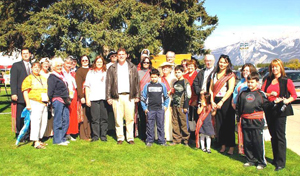HAWS
Jasper Haws Descendants
Jasper Haws was another colourful Métis who is notable in history. Born in 1770, Jasper was uprooted from his Maryland home during the American Revolution. His parents, United Empire Loyalists, joined a migration of people leaving the United States in order to maintain their loyalty to the British Crown.
Jasper remained with his parents in Sorel, Quebec until, at the age of 25, he travelled to Montreal and entered the service of Mr. Canavan and Mr. Cazelet, affiliates of the North West Company. Hired as a middleman, Jasper’s first job with the NWC was to sit anywhere between the bow and stern of the boat (hence the name middleman) and paddle from Montreal to Fort William and then on to Red River for the winter. There, he learned the fur trade business and delivered goods to outlying trading posts.
From 1797 to 1802, Jasper remained in the service of the NWC plying the waters of the Missouri. By 1804 he had worked his way west into the Athabasca River District (now Alberta). In 1815, after 20 years of service, Jasper was appointed manager of a post. His name became associated with the post and with the town and park that followed.
Gateway to the West
In 1813, the NWC built Rocky Mountain Portage House on Brûlé Lake as a provision depot for brigades crossing the Athabasca Pass to the Pacific. When Jasper Haws took command of the post in 1815 it became known as “Jasper’s House,” to avoid confusion with Rocky Mountain House on the North Saskatchewan River. Under the trained eye of Jasper Haws, the post became the centre of a modest and diverse community responsible for meeting transportation and supply needs, caring for horses grazing in the valley, and trading goods for meat and furs with Aboriginal groups, including Iroquois and Métis peoples.
Jasper married an Iroquois woman and fathered no less than five children – three boys and at least two girls. He remained at Jasper House until 1821. When the NWC was forced to amalgamate with the Hudson’s Bay Company, he was suddenly without work. Leaving his wife and daughters with family, Jasper returned with his sons to Quebec. They homesteaded in Hinchinbrooke, Quebec until his death in 1855. Haws Creek in the Chateauguay Valley still bears his name today.
Jasper’s House in 1830, under the control of the Hudson’s Bay Company, Jasper House was relocated to the west bank of the Athabasca River, 1.4 kms north of Jasper Lake. By that time, the site was a strategic point on two trans-mountain routes: one through the Athabasca Pass to the southwest and the second via Yellowhead Pass to the northwest. In addition, the post was optimally located for the movement of Aboriginal peoples travelling the historic route through the Snake Indian Pass into the upper Smoky River drainage area and into the Fraser River watershed and the interior of British Columbia.
For the next 20 years, the new Jasper House supported HBC brigade traffic over the mountains to the Columbia district and facilitated the transfer of trade goods and furs from east to west. The post only operated sporadically after 1853, and fell into decline following trade reorganization. Trader Henry John Moberly ran the post seasonally from 1858 until 1861. Jasper House was closed officially by the HBC in 1884, although by that date the post had been abandoned for many years.
The World Stage
In 1492, the economies of Europe, Asia and Africa were forced to recognize a new player, the Americas. In the 1600s, the global market had discovered a commodity worth its weight in gold in the North American interior – furs. By the late 1700s, the world fur market had largely been captured by two companies, the London-based Hudson’s Bay Company and the North West Company with its headquarters in Montreal.
Exploration
At the turn of the 19th century, commercial rivalry between the two giants was anything but friendly and the drive to profit led to unprecedented economic expansion in North America. Competition drove the two companies through fur-rich landscapes to the edge of the Rockies. David Thompson, in the employ of the NWC, pushed through the Rockies via Athabasca Pass in 1811.
Nation Building
To entrench their position as stakeholders, the NWC and the HBC worked rapidly to build forts and trading posts that gave them a physical presence on the land and created loyalties amongst their Aboriginal trading partners. The establishment of the fur-trade, from sea to sea, across what is now Canada, served to protect against expansion by an aggressive United States of America and laid the foundation for Confederation.
The Name Lives On
In 1907, Jasper Forest Park was created and the name Jasper was chosen because of its historic association with the area. In 1913, when the name Fitzhugh fell out of favour, the name Jasper was also adopted by the townsite within the park boundaries.
Jasper House was designated a national historic site in 1924. The reason for national significance is that for half a century it was a main support of
the trade route across the mountains and an important point for all persons journeying through the Yellowhead and Athabasca passes.
Jasper’s Legacy
It is a wonder that a simple fur trader in a time and place of great flux can have his name immortalized and renowned throughout the world.

